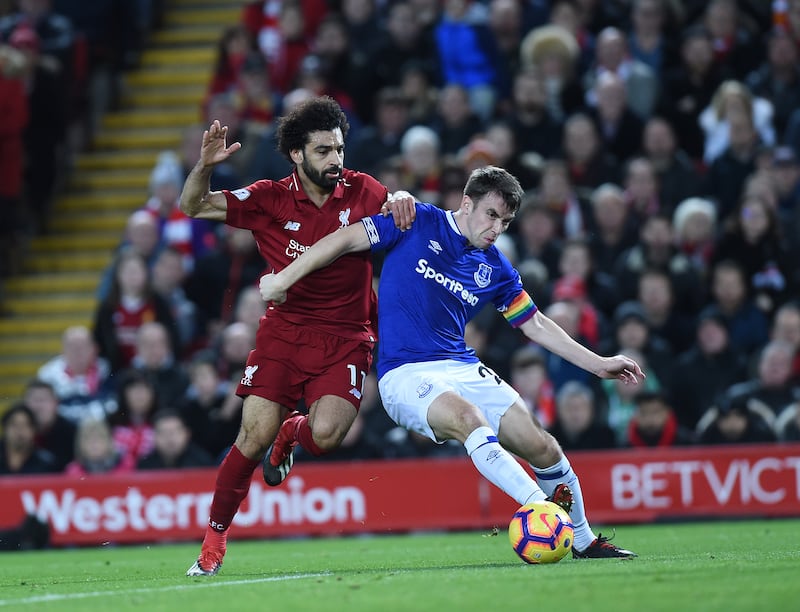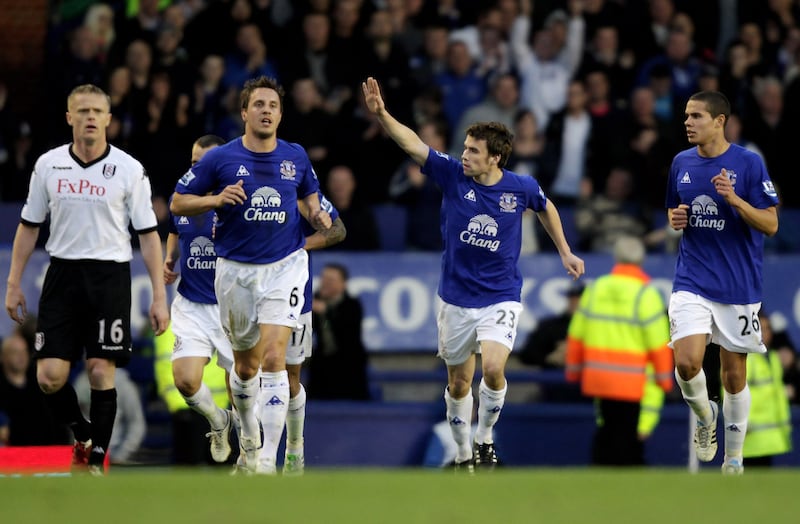After Séamus Coleman’s first appearance in a Merseyside derby, almost 13 years ago, the Everton manager David Moyes singled out his young full-back in the post-match press conference, using him, softly, for a propaganda point. The context was Liverpool’s new ownership. Only a couple of days earlier they had been bought by Fenway Sports Group, with all that implied about investment and recruitment.
Coleman had created Everton’s first goal, outflanking two Liverpool players on the edge of the box, and conscious of the long shadow being cast across Stanley Park by towering American money, Moyes wanted to say something about eagle-eyed scouting and smart spending. Even in an era of obese overseas investment in the Premier League, and the shady hall of mirrors that accompanied it, gold was still available for £60,000.
The comparative pittance that Everton paid to Sligo Rovers inspired the terrace chant that has soundtracked Coleman’s monumental career at Goodison Park. Tonight at Anfield he will make his 400th appearance for Everton, just the 19th player to reach that milestone in more than 140 years of the club’s existence.
In a fickle, venal, crooked, cut-throat business Coleman has played the game by other rules. He has been honourable and wholehearted and sincere, qualities that are beyond the detection of data analytics. He has never tried to engineer a move away from Everton, with the financial windfall that would have entailed in his prime, and there has never been a provocative transfer “whisper” planted in the media by Coleman’s agent to lubricate contract negotiations. Word about Coleman’s latest Everton deal would just emerge, to no one’s surprise.
READ MORE
In the final few months of what could be his last Everton contract, Coleman is leading the club in another relegation battle. When they were fighting on their backs in the closing months of last season Coleman postponed a hernia operation and played through the discomfort. Just like every player in their early 30s, Coleman has seen his game reduced by decay, but what Everton desperately needed on the field was the spirit of him as a footballer.

On the night they secured their Premier League survival, coming from behind to beat Crystal Palace at Goodison Park, the Everton manager Frank Lampard pulled Coleman into the middle of the dressingroom to pay a personal tribute in front of the group. Spotting somebody filming the scene on their phone, he made a deliberate gesture of approval towards the citizen cameraman, no doubt knowing that what he was about to say would reach a wider audience.
“This fella is ... one of the best – the best – people I’ve ever met. As a man, as a man, and who you are.”
With Lampard’s arm draped around him Coleman stood stony-faced, mortified to be standing at the teacher’s desk as the best boy in the class. The really interesting part, though, was the reaction of the dressingroom. As soon as Lampard stopped talking, the place erupted in cheers, rapturous cheers. That was how they felt about him.
When Crystal Palace visited Goodison Park again, a few months later, Coleman was interviewed for a long piece in the matchday programme. He had just sat down with the reporter when he overheard that a youth player was about to sign his first professional contract in the room next door. Coleman politely excused himself for a few minutes.
“Never mind being a leader or captain,” said Coleman in the interview. “I just want to be a good person. I want lads to feel at home here as much as possible but, at the same time, have standards on top of that.”
That is how he has carried himself, unspoilt by the giddiness of life as a Premier League player. His endurance and his loyalty outstayed his excellence; that outcome was dictated by his character. Gavin Cooney excavated the records for The42 and discovered that by appearing in his 14th Premier League season Coleman became the longest serving one-club player still active in the division, followed by Lewis Dunk at Brighton, Harry Kane at Spurs and Jordan Henderson at Liverpool.
In the modern game, where everybody has a price, and everyone wants a cut of the action, what is the value on loyalty? Coleman’s career was never dragged into that febrile equation. People will say that he should have left and challenged himself in another environment. But why? He was invested in a place where he believed he could make a difference. Professional football is one of the few work places where that attitude would be queried or disparaged.
Coleman prospered too in an era when full-back play gained layers of sophistication, like smartphones. The top clubs were no longer interested in full-backs that merely performed basic functions. During Pep Guardiola’s time at Manchester City, three of his 10 most expensive signings have been full-backs. City spent more on Joao Cancelo than they did on Erling Haaland.
[ The top 25 Irish players to play in the Premier League eraOpens in new window ]
[ Séamus Coleman’s love of the game remains undimmed despite march of timeOpens in new window ]
Guardiola has a taste for “inverted full backs”, where one of them steps into central midfield and creates an overload. Liverpool have dabbled in that caper with Trent Alexander-Arnold, and Arsenal have been employing Oleksandr Zinchenko in that role. That probably wouldn’t have suited Coleman, even in his prime. Everton, though, didn’t need him to be something else.
He stands in the long tradition of great Irish full-backs, stretching back to Tony Dunne and Shay Brennan at Matt Busby’s Manchester United, and through the generations. There was one extraordinary sequence, around the turn of the century, when for five years in a row at least one Irish full-back appeared in the Professional Footballers Association [PFA] team of the season, chosen by their peers.

It started with Denis Irwin in 1998-99 and was carried on by Gary Kelly and Ian Harte in the following year, then Stephen Carr, Steve Finnan, and Carr again. The last Irish player to appear in that selection was Coleman, nine years ago now. As Irish players became an endangered species in the top tier of English football, Coleman was an enduring monument to hard work and admirable values and good conscience and wringing every last drop from your talent.
No matter how money and greed disfigured the game, what Coleman represented had a stainless quality. For the time he has left on the pitch, we should remember to cherish him.

















